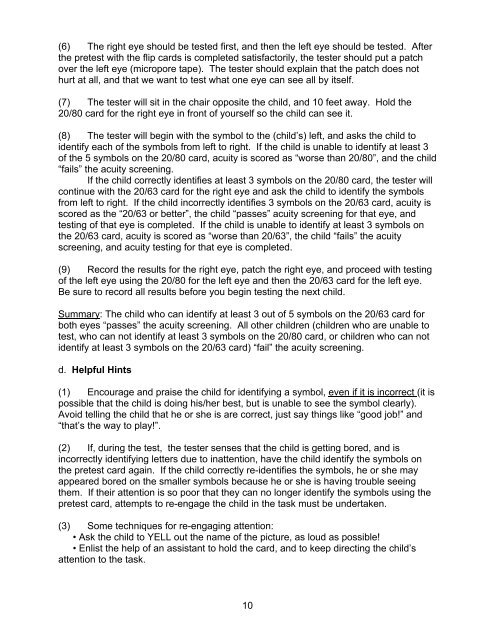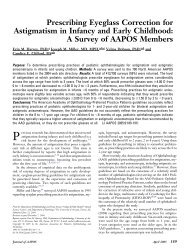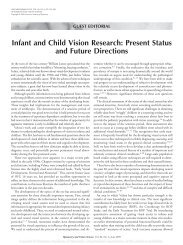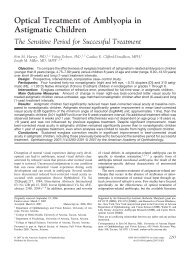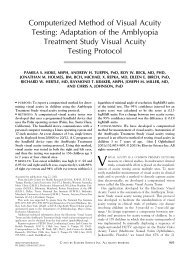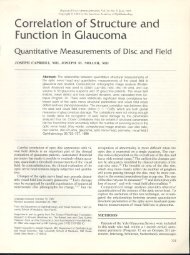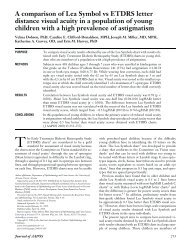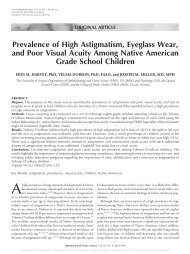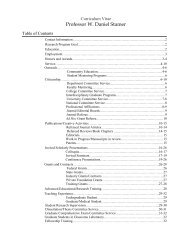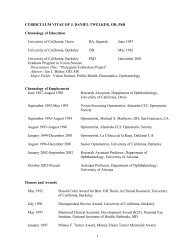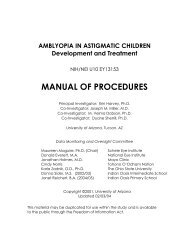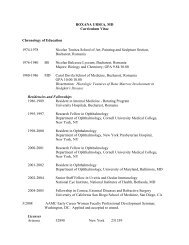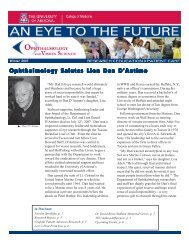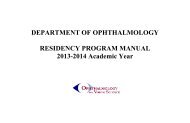Head Start Vision Screening Manual - University of Arizona
Head Start Vision Screening Manual - University of Arizona
Head Start Vision Screening Manual - University of Arizona
You also want an ePaper? Increase the reach of your titles
YUMPU automatically turns print PDFs into web optimized ePapers that Google loves.
(6) The right eye should be tested first, and then the left eye should be tested. After<br />
the pretest with the flip cards is completed satisfactorily, the tester should put a patch<br />
over the left eye (micropore tape). The tester should explain that the patch does not<br />
hurt at all, and that we want to test what one eye can see all by itself.<br />
(7) The tester will sit in the chair opposite the child, and 10 feet away. Hold the<br />
20/80 card for the right eye in front <strong>of</strong> yourself so the child can see it.<br />
(8) The tester will begin with the symbol to the (child’s) left, and asks the child to<br />
identify each <strong>of</strong> the symbols from left to right. If the child is unable to identify at least 3<br />
<strong>of</strong> the 5 symbols on the 20/80 card, acuity is scored as “worse than 20/80”, and the child<br />
“fails” the acuity screening.<br />
If the child correctly identifies at least 3 symbols on the 20/80 card, the tester will<br />
continue with the 20/63 card for the right eye and ask the child to identify the symbols<br />
from left to right. If the child incorrectly identifies 3 symbols on the 20/63 card, acuity is<br />
scored as the “20/63 or better”, the child “passes” acuity screening for that eye, and<br />
testing <strong>of</strong> that eye is completed. If the child is unable to identify at least 3 symbols on<br />
the 20/63 card, acuity is scored as “worse than 20/63”, the child “fails” the acuity<br />
screening, and acuity testing for that eye is completed.<br />
(9) Record the results for the right eye, patch the right eye, and proceed with testing<br />
<strong>of</strong> the left eye using the 20/80 for the left eye and then the 20/63 card for the left eye.<br />
Be sure to record all results before you begin testing the next child.<br />
Summary: The child who can identify at least 3 out <strong>of</strong> 5 symbols on the 20/63 card for<br />
both eyes “passes” the acuity screening. All other children (children who are unable to<br />
test, who can not identify at least 3 symbols on the 20/80 card, or children who can not<br />
identify at least 3 symbols on the 20/63 card) “fail” the acuity screening.<br />
d. Helpful Hints<br />
(1) Encourage and praise the child for identifying a symbol, even if it is incorrect (it is<br />
possible that the child is doing his/her best, but is unable to see the symbol clearly).<br />
Avoid telling the child that he or she is are correct, just say things like “good job!” and<br />
“that’s the way to play!”.<br />
(2) If, during the test, the tester senses that the child is getting bored, and is<br />
incorrectly identifying letters due to inattention, have the child identify the symbols on<br />
the pretest card again. If the child correctly re-identifies the symbols, he or she may<br />
appeared bored on the smaller symbols because he or she is having trouble seeing<br />
them. If their attention is so poor that they can no longer identify the symbols using the<br />
pretest card, attempts to re-engage the child in the task must be undertaken.<br />
(3) Some techniques for re-engaging attention:<br />
• Ask the child to YELL out the name <strong>of</strong> the picture, as loud as possible!<br />
• Enlist the help <strong>of</strong> an assistant to hold the card, and to keep directing the child’s<br />
attention to the task.<br />
10


